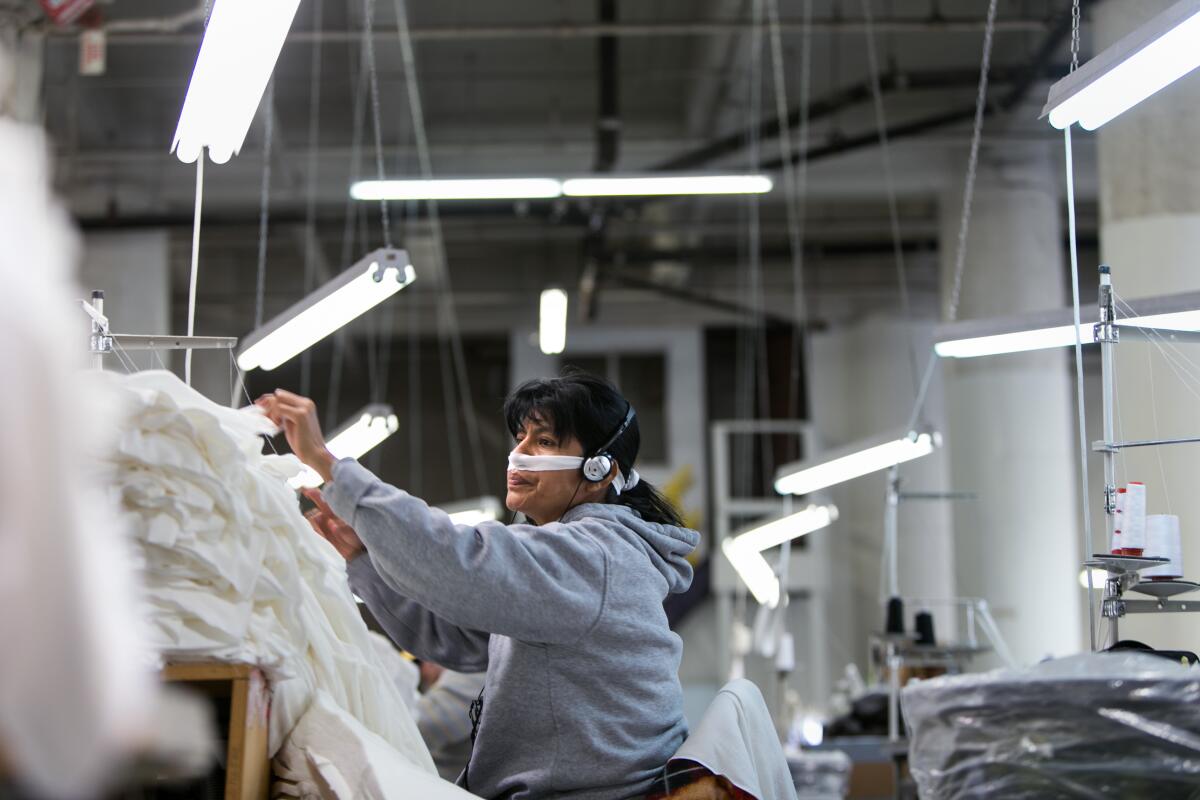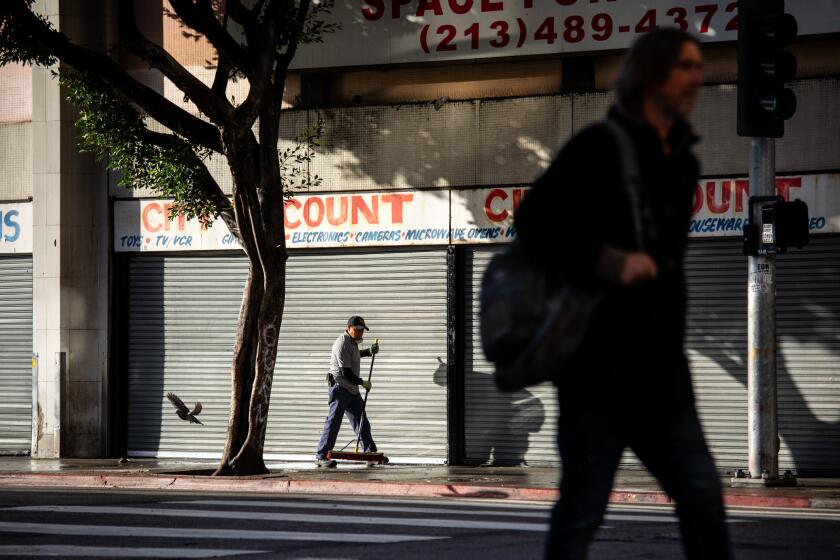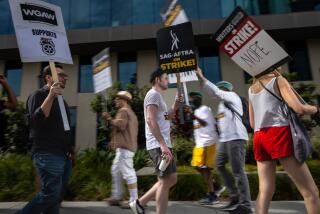The sweatshops are still open. Now they make masks

- Share via
Rosario Ruiz got a call from her boss in early April: The small factory on the southern edge of downtown L.A. where she sews T-shirts had work for her. It was getting into the mask business.
The next morning, she left the home she shares with her 70-year-old father and walked the mile to work, fearful that she could catch the virus on the bus and pass it on to him.
When she arrived, she learned her pay had changed. Instead of making 5 cents for every label that she sewed onto a shirt, she would be paid 20 cents for each pair of elastic straps she sewed onto a fabric mask.
Before, she had made anywhere from $250 to $400 per week, depending on how many hours she worked and how simple the pieces were to sew. Now, she could get through about 300 masks per day, and expected to get $350 at the end of a 50-hour workweek.
The minimum wage in L.A. is $13.50, but Ruiz would make $7 an hour.
Mayor Eric Garcetti has called on the city’s garment industry to step up during the COVID-19 crisis, as hospital workers face shortages of personal protective equipment and all Angelenos are required to wear masks when entering stores.
In late March, City Hall launched a program called L.A. Protects to facilitate the manufacture and sale of 5 million non-medical masks for frontline workers in essential sectors. The city has partnered with a number of manufacturers known for following labor law, such as Reformation and Buck Mason, and is connecting more than 1,800 buyers to over 500 approved producers making masks to specifications provided by Kaiser Permanente. So far, nearly 2 million masks have been produced under the program.
Before dawn six days a week, Norma Ulloa left the two-bedroom apartment she shared with four family members and boarded a bus that took her to a stifling factory on the outskirts of downtown Los Angeles.
But even as they’re called upon to make protective gear during the pandemic, many garment workers in factories across Los Angeles are facing the same sub-minimum-wage pay and poor working conditions that have been standard in the industry for years.
Marissa Nuncio, the director of downtown L.A.’s Garment Worker Center, said many workers are simply out of a job during the coronavirus lockdown, as brick-and-mortar retail stores close their doors and overwhelmed e-commerce platforms such as Amazon prioritize shipping food and other necessities. Many garment workers are undocumented or paid under the table, rendering them ineligible for unemployment or other government benefits. The center has set up an emergency relief fund and is making food deliveries to workers facing the prospect of no wages for weeks to come.
But dozens of worker center members like Ruiz have reported their factories switching over to mask production in recent weeks while maintaining conditions that put workers at risk of infection.
“This is an industry that had workers working in very unsanitary conditions prior to [COVID-19], and we’re seeing a lot of business as usual now,” Nuncio said. “When workers are producing something that is so critically needed it’s unacceptable that they’re having to continue to work in unsafe conditions and for sweatshop wages.”
Businesses do not need official approval to remain open, but essential businesses that do continue to operate are required to follow infection control practices: keeping people six feet apart, providing access to hand-washing facilities or hand sanitizer, posting signs instructing people not to enter if they are experiencing symptoms of respiratory illness, and following L.A. County Department of Public Health recommendations on disease control.
Each morning when Ruiz arrived at the factory, her boss doled out masks for workers to wear, piled up enough material for a day’s work, then left. The workers spread out their stations as far as they could to keep six feet apart, but the room was windowless and stuffy, with the doors kept shut. The CDC recommends that workplaces “increase ventilation by opening windows or adjusting air conditioning” to reduce the spread of the novel coronavirus.
Here’s who qualifies for paid sick leave, and who doesn’t, under the new federal emergency coronavirus relief package.
Ruiz has a green card, unlike many of the estimated 45,000 workers in L.A.’s garment industry, but hasn’t been able to find other work since coming to the U.S. from El Salvador in 2017 to take care of her father. She has avoided signing up for healthcare or SNAP benefits out of fear that the Trump administration might use that to threaten her immigration status. Since she is paid off the books, she isn’t eligible for unemployment insurance if work dries up.
She’s afraid of getting sick but needs to keep working to pay rent and buy food.
“I don’t think that these working conditions are right,” she said, adding that she wished her job site provided hand sanitizer, and required other workers to disinfect their hands on arrival (there is soap in the bathrooms). She also wishes the pay was different: “I want to be paid per hour, not per piece.”
Federal statistics show that basic labor protections are hard to find in the L.A. garment industry. A 2016 Department of Labor survey found that 85% of garment shops in Southern California failed to pay the minimum wage. Investigators in the Labor Department’s Wage and Hour Division recovered more than $2 million in back wages for 1,042 garment workers in 2019, up from $1.5 million the year before.
The garments made in L.A. by underpaid workers in sweatshop conditions have been linked to orders from major retailers such as Fashion Nova, Forever 21, TJ Maxx and Ross Dress for Less in recent years. The workers interviewed for this article said that the masks they were sewing had no labels, and they did not know where they were being sold. They did not know the legal names of the businesses they were working for, as is common in the under-the-table industry, but shared the locations and photos of their workplaces with The Times.
The industry’s reliance on subcontracting, combined with state law that makes it difficult to hold retailers accountable, has left regulators playing wage theft whack-a-mole: Small factories under investigation can shut down and reopen under a different name overnight, both to avoid fines and present clients with a clean record.
The difficulty of tracking down the right company to pay stolen back wages led the state to pass a law in 1999 that established the Garment Restitution Fund. Manufacturers registering as new businesses would pay a small fee into the fund, which could be drawn upon to pay out wage claims.
For most of the fund’s history, the wage claims outnumbered the registration fees, and workers faced a years-long waiting list for restitution. In 2019, however, Southern California lawmakers pushed for the state to chip in, and Gov. Gavin Newsom included more than $16 million in the state budget to clear the wait list.
Nuncio, the Garment Worker Center director, said the new funds for back wages are an improvement, but that workers during the crisis still need basic protections now.
“Most of society is being asked to stay home, because that’s the safer thing to do,” Nuncio said. “If we’re elevating garment workers to essential workers, brands need to elevate their labor standards and offer some form of hazard pay.”
Here’s how to file for unemployment benefits if you’ve lost work because of the coronavirus outbreak. Read this explainer for eligibility requirements and how the program works.
Santiago, who asked to be identified only by his first name out of fear of reprisal from his employer, got the call that his downtown L.A. factory was switching to masks the same week as Ruiz in early April.
His boss hadn’t paid him his wages for two weeks before that, blaming the loss of business from the coronavirus, but Santiago had been going in whenever he could, hoping to eventually get paid.
Before the crisis, he had made $260 a week sewing shirts for 9 hours a day, plus half a day on Saturdays. He is undocumented, and has been working in the garment industry for 17 years.
“I’d like a just salary for those of us who are working in this time of crisis,” Santiago said. “Medical workers are being called heroes for risking their lives, and I think those of us working to make masks to support them deserve to be put in the same category.”
He estimated that the 15 people working in his factory churned out 1,500 to 2,000 fabric masks per day. The doors and windows of the shop were kept closed, and workers could spread out more than usual, but still sat only three feet apart.
Santiago finally got paid at the end of his first week making masks: $230, in cash, for 50 hours of work. That’s $4.60 an hour, for essential work.
More to Read
Inside the business of entertainment
The Wide Shot brings you news, analysis and insights on everything from streaming wars to production — and what it all means for the future.
You may occasionally receive promotional content from the Los Angeles Times.













